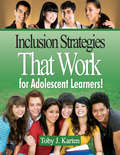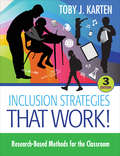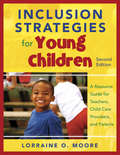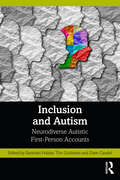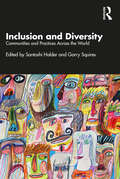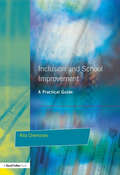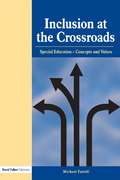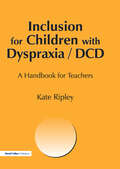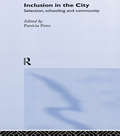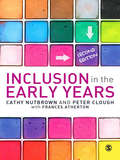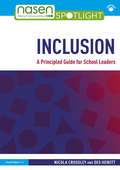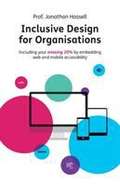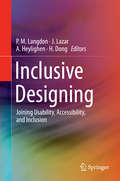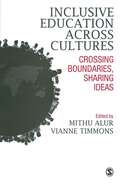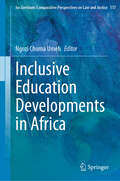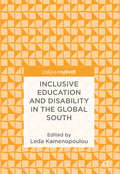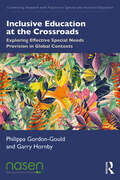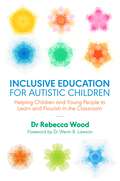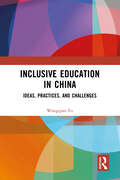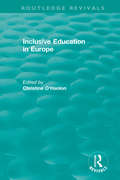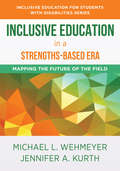- Table View
- List View
Inclusion Strategies That Work for Adolescent Learners!
by Toby J. KartenBacked by the author’s three decades of experience, this reader-friendly guidebook provides teachers with a practical approach for creating a successful inclusive secondary classroom. Toby J. Karten helps teachers use a variety of strategies, including differentiated instruction, universal design for learning, brain-based learning, RTI, and evidence-based practice. With helpful forms, activities, graphic organizers, and quotations throughout, this resource: <p><p> Outlines the theoretical background for creating an inclusive classroom environment <p> Describes the psychosocial, cognitive, physical, and moral development of adolescents and how they affect teaching practice <p> Provides research-based practices to maximize and honor learners’ potentials and strengths
Inclusion Strategies That Work!: Research-Based Methods for the Classroom
by Toby J. KartenThe go-to book for including ALL learners in educational success! Teaching students with diverse needs require educators to employ empathy, responsiveness, and patience. This book has long been the indispensable resource for K-12 teachers as they confidently form lesson plans and strategies for inclusion. In this new edition, Toby J. Karten’s data-driven methods are updated with the latest research and policy developments. The book’s content includes: Updated information on ADA, IDEA, writing IEPs, transitional services, classifications, RTI, metacognitive strategies, and links to the Common Core Tips for working with families and making them an integral part of the inclusive team An overview of special education legislative terminology Interactive online forms for planning, documentation, and collaboration
Inclusion Strategies That Work!: Research-Based Methods for the Classroom
by Toby J. KartenThe go-to book for including ALL learners in educational success! Teaching students with diverse needs require educators to employ empathy, responsiveness, and patience. This book has long been the indispensable resource for K-12 teachers as they confidently form lesson plans and strategies for inclusion. In this new edition, Toby J. Karten’s data-driven methods are updated with the latest research and policy developments. The book’s content includes: Updated information on ADA, IDEA, writing IEPs, transitional services, classifications, RTI, metacognitive strategies, and links to the Common Core Tips for working with families and making them an integral part of the inclusive team An overview of special education legislative terminology Interactive online forms for planning, documentation, and collaboration
Inclusion Strategies for Young Children: A Resource Guide for Teachers, Child Care Providers, and Parents
by Lorraine O. Moore"This book makes inclusion a much easier way to work with children than the resource room of the past. It places the responsibility of adaptation on the teachers and the school system versus the old method of pounding a square peg into a round hole. I truly appreciated the detailed description of the learning cycle and will use it in my own lesson plans beginning tomorrow!"—Stacey B. Ferguson, Multiage Teacher North Bay Elementary School, Bay Saint Louis, MSConcrete methods for enhancing young children′s growth and development!This user-friendly book helps general and special education teachers work with 3- to7-year-olds in school programs, early childhood settings, and other inclusive settings designed to meet the needs of young children. Lorraine O. Moore provides more than 350 proven strategies to promote success for beginning learners, especially those who have special needs. This second edition contains updated information on IDEA 2004, resource listings of organizations, a glossary, and reproducible handouts for students and parents. Comprehensive in its approach, this invaluable resource offers current brain research about learning and behavior challenges, individual chapters on assessment and specific disabilities, and developmentally appropriate practices to help children:Increase large and small motor skills Develop emotionally and socially Acquire better communication, listening, and attention skills Work toward self-management of behaviors Develop preparatory reading, writing, and math skillsInclusion Strategies for Young Children gives adults the essential tools to help young children attain their full potential in school and all areas of their lives.
Inclusion and Autism: Neurodiverse Autistic First-Person Accounts
by Santoshi Halder, Tim Goldstein and Dave CaudelThis book provides a fertile ground for having the collective voices of the autistic people to understand inclusion and the enigma of the autism spectrum from the neurodiverse lens. The book brings forth the first-person account of autistic adults and unravels various facts about autism spectrum disorder. It offers a fresh outlook on autistic adults, reflecting on inclusion, their challenges, and strengths presenting crucial elements for a successful inclusive model and the foundation of a robust and effective support delivery reinforcing the inclusion of autistic people in society. Through a range of neurodiverse voices, the book presents the world their unique perspectives. It offers valuable insights for future directions and strategic effective pathways stressing the need for a neuro-diverse lens and strength-based focus of support for manifestation and nurturance of abilities and strengths of people.Inclusive and incisive in its making, this book would be useful to the departments of Special Education, Psychology and Applied Psychology, Social Work, Sociology, and Public Health. It would also be an invaluable companion to special educators, in-service and prospective teachers, policy makers, parents, professionals from government and non-government departments, and researchers in the field of disability, diversity, and equity from around the world.
Inclusion and Diversity: Communities and Practices Across the World
by Santoshi Halder Garry SquiresThis volume presents a comprehensive overview of inclusion and diversity in education across the globe. It examines how more inclusive education systems can be built and covers areas and topics such as disability studies, sexual minorities, and indigenous communities, marginalized communities among others. The book presents perspectives of experienced and cutting-edge researchers on inclusive practices that facilitates participation, equity, and access from across countries such as India, the USA, Australia, the UK, Canada, South Africa, Japan, Pakistan, Rome, Hungary, Sweden, and others. It discusses how spoken language, race, gender, and religion contribute to inclusion and marginalization. The volume also explores ideas on how schools and educational systems can respond to diversity-related issues, and the lessons learned about how to improve capacities for further inclusion. Additionally, it provides a holistic understanding of the classroom practices and interventions adopted to handle the problems of students with diverse needs. The book volume facilitates understanding of the broader spectrum of various diversities existing in our society and also the strategic pathways for their inclusion. This incisive and comprehensive volume will be of interest to students, teachers, and researchers of education, inclusion and diversity, equity and access, disability studies, educational psychology, social work, sociology, and anthropology. It will also be useful for teacher training course, and anyone who is associated with or working in the field of diversity and inclusion.
Inclusion and School Improvement: A Practical Guide
by Rita CheminaisThis practical comprehensive book for senior managers and inclusion coordinators covers all the essential aspects of how to manage inclusion more effectively. It informs coordinators about effectively managing their own continuing professional development, and that of other staff working within the inclusion team. The book explores the role of inclusion assistants, managing an inclusive resource center, identifying barriers to learning for a diversity of pupils; and applying the Index for Inclusion, the Business Excellence Model and the Ofsted school self-evaluation model to review and support inclusive school practice. It also looks at the role of external professionals, support services, beacon, special and specialist schools, national initiatives and ICT enabling schools to improve their inclusive provision.
Inclusion at the Crossroads: Special Education--Concepts and Values
by Michael FarrellAnswering challenging questions such as "Does the term SEN mean anything any more?" and "Is SEN biologically or socially determined?" this book: * Makes sense of the controversy surrounding Special Educational Needs with clear sign posted information * Is comprehensive in the range of Special Educational Needs it covers * Clarifies information with case studies
Inclusion for Children with Dyspraxia: A Handbook for Teachers
by kate RipleyThis book is about children with dyspraxia: developmental co-ordination disorders (DCD) and what teachers and other professionals can do to promote their learning and their social inclusion in a mainstream setting. The author addresses issues which affect access to the curriculum in Key Stages 1-4 and offers strategies to support children which have proved effective to experienced practitioners and can be managed in a group or class context. A key component of the book is an understanding of the emotional and social needs of children with dyspraxia.
Inclusion in the City: Selection, Schooling and Community
by Patricia PottsInclusion in the City explores inclusion and exclusion in the context of policy and practice in one English city - Birmingham. Here, a commitment to redressing the inequalities experienced by many learners has been inhibited by difficulty in securing agreement to a definite policy for inclusion and, consequently, in sustaining initiatives for strengthening participation in community comprehensive education.Grounded in an understanding of inclusion as a political and moral project, the book presents a range of perspectives from policymakers and practitioners. Detailed case studies, based on research specially undertaken for this book, relate inclusion to key issues in contemporary education such as; the effects of selection by attainment; faith schools and their communities; single sex education and inclusive schools; participation in further education; and social mobility.Insightful, thought provoking and original, Inclusion in the City detaches processes of inclusion and exclusion from the language of educational reform. In so doing it highlights links between participation in education and poverty, gender and cultural background, as well as the absence of a link between urban and educational renewal.
Inclusion in the Early Years
by Cathy Nutbrown Peter CloughIn this insightful text, the authors argue for a broad definition of inclusion, not limited to those with learning difficulties or impairment. The book presents a number of original stories generated from a recent research project carried out by the authors, and shows how to apply theory to practice. This new and revised edition includes an increased focus on: -Inclusion as a political issue -Social class -Poverty -Children's rights -The inclusion of gay and lesbian parents and staff -Practical activities including workshops and role-plays -Different policies around the UK This text is essential for all Early Years students, practitioners and researchers who want to become familiar with current research into inclusion and to develop ways of drawing on such studies to inform and develop their own inclusive practices. Cathy Nutbrown is Professor of Education and Director for Research at the University of Sheffield. Peter Clough is Honorary Professor of Education at the University of Sheffield Frances Atherton is Head of Department of Early Childhood Studies, at the University of Chester.
Inclusion in the Early Years: Critical Analyses And Enabling Narratives
by Cathy Nutbrown Peter Clough Frances AthertonThis insightful text shows how the attitudes of adults in early years settings can influence practice. The authors argue for a broad definition of inclusion, not limited to those with learning difficulties or impairment, but addressing factors affecting all members of the learning community. The book shows how the lives of practitioners, parents and children have been affected by inclusive and exclusionary practices. This new and revised edition includes an increased focus on: - inclusion as a political issue - social class - poverty - children's rights - gay and lesbian parents and staff This text is essential for all early years students, practitioners and researchers who want to become familiar with current research into inclusion and to develop ways of drawing on such studies to inform and devleop their own inclusive practices. Cathy Nutbrown is Professor of Education and Director for Research at the University of Sheffield. Peter Clough is Honorary Professor of Education at the University of Sheffield Frances Atherton is Head of Department of Early Childhood Studies, at the University of Chester.
Inclusion: A Principled Guide for School Leaders (nasen spotlight)
by Des Hewitt Nicola CrossleyThis valuable and accessible guide navigates school leaders and those in training through a number of key areas of inclusion, providing context and understanding, helpful definitions, examples of leadership in action, and ten essential principles of inclusive leadership. Inclusion: A Principled Guide for School Leaders discusses what a culture of inclusion should look like: in classes, in schools, and in the education sector more widely. Each chapter acts as a think piece to stimulate debate, to reflect upon the purpose of education, and to ask how far we have come in embracing inclusion. The book also offers suggested actions for principled leaders and illustrative case studies to bring the theory to life, taken from a range of schools and spanning a wide number of topics, including: Inclusive Learning Partnerships with Learners and Families Special Educational Needs Disadvantage and Socio-Economic Poverty Culture, Language and Ethnicity This book explores a variety of issues in inclusion, highlighting the implications for school leaders and offering an approach to develop learning for marginal groups through effective strategic leadership. It will be essential reading for SENCOs, middle and senior leaders, but equally of interest to those who aspire to be inclusive leaders of the future.
Inclusive Classrooms: Video Cases on CD-ROM Activity and Learning Guide to accompany Exceptional Lives Special Education in Today's Schools
by Anne M. Bauer Stephen D. KroegerSkills and knowledge for creating inclusive classrooms.
Inclusive Design For Organisations: Including Your Missing 20% By Embedding Web And Mobile Accessibility
by Jonathan HassellMost organisations are oblivious to, or terrified about, web accessibility. <p><p> You may be aware that 20% of your customers - people with disabilities - could be clicking away from your websites or mobile apps every day, without having bought anything or found the information they needed. You may have received complaints about accessibility problems you don't understand, with people asking for what seem like impossible fixes. Your web teams may have read the industry standard WCAG guidelines, but found them impenetrable. You probably know you could be sued if you don't do the right thing, but you don't know how far you need to go to prevent that. And apart from eliminating risk, what else is in it for your organisation? <p> In this book, award-winning international accessibility thought-leader Jonathan Hassell shows you how to transform your organisation to consistently and cost-efficiently create websites, mobile apps and other digital products that are usable for all of your customers. <p> Inclusive Design for Organisations gives you a clear, strategic business-aligned framework how to embed accessibility policies and processes consistently throughout your organisation, and how to measure the return on your investment. <p> With insights from leading worldwide accessibility experts who have implemented these processes in their organisations, this book comes with a free library of downloadable support tools, templates, podcasts and videos to help you on your journey to accessibility maturity. <p> Inclusive Design for Organisations, and its companion, Inclusive Design for Products, will help you comply with both parts of the new International Standard ISO 30071-1.
Inclusive Design and Accessibility Paradigms in Lebanon: University Built Environments Case Studies
by Itab ShuaybThis book describes the disability rights movement that started in the USA and its influence on the disability rights movement in Lebanon, which has led to the endorsement of the Lebanese Disability Act 220/2000. The book introduces the reader to the Lebanese Disability Act 220/ 2000, its definition of disability, and its relation to the medical and social models of disabilities and then articulate the Act articles. Then, it defines the inclusive design paradigm that acknowledges the needs of all people at each stage of their life cycle and presents the difference between inclusive design and accessibility and disability notions. Moreover, the book reviews the different international accessible design standards (American and French) that are adopted in Lebanon with the absence of a nationalized Lebanese design standard and its effect on eliminating barriers and enhancing accessibility at university buildings. Besides, the book presents students' experiences and their satisfaction with the university built environments. 6 university buildings case studies at the American University of Beirut are assessed and analysed to check whether they adopt the inclusive design approach and then propose inclusive design solutions for both heritage and modern university buildings. What makes the book unique is its combination of empirical and theoretical application of inclusive design. The last section, reflects the author’s inclusive design teaching pedagogy. In this section, the author shares samples of students’ class design project and provides recommendations and guidelines for teaching inclusive design so it becomes mainstream.
Inclusive Designing
by P. M. Langdon J. Lazar A. Heylighen H. Dong'Inclusive Designing' presents the proceedings of the seventh Cambridge Workshop on Universal Access and Assistive Technology (CWUAAT '14). It represents a unique multi-disciplinary workshop for the Inclusive Design Research community where designers, computer scientists, engineers, architects, ergonomists, policymakers and user communities can exchange ideas. The research presented at CWUAAT '14 develops methods, technologies, tools and guidance that support product designers and architects to design for the widest possible population for a given range of capabilities, within a contemporary social and economic context. In the context of developing demographic changes leading to greater numbers of older people and people with disabilities, the general field of Inclusive Design Research strives to relate the capabilities of the population to the design of products. Inclusive populations of older people contain a greater variation in sensory, cognitive and physical user capabilities. These variations may be co-occurring and rapidly changing leading to a demanding design environment. Recent research developments have addressed these issues in the context of: governance and policy; daily living activities; the workplace; the built environment, Interactive Digital TV and Mobile communications. Increasingly, a need has been identified for a multidisciplinary approach that reconciles the diverse and sometimes conflicting demands of Design for Ageing and Impairment, Usability and Accessibility and Universal Access. CWUAAT provides a platform for such a need. This book is intended for researchers, postgraduates, design practitioners, clinical practitioners, and design teachers.
Inclusive Education Across Cultures: Crossing Boundaries, Sharing Ideas
by Mithu Alur Vianne TimmonsThis comprehensive collection provides a global perspective on inclusive education. The existing literature delves into whether inclusive practice is about educating children with disabilities or children from diverse backgrounds. The articles in this compilation assert that it is both. Inclusive Education Across Cultures: Crossing Boundaries, Sharing Ideas brings together multiple perspectives to present a compelling case for inclusive practice in different areas of inclusive education, ranging from policy initiatives to practices on the ground level, and advocating and creating awareness. The articles present examples that are explicitly disability-focussed and at the same time present a vision of inclusion that is about societal reform. These articles provide a voice to the people living with disabilities and enable us to learn from their stories. They not only provide theoretical information, but also connect theory and practice by discussing implemented models and practical resources. This work will be a valuable resource material for all those involved in the study of education, social work and psychology.
Inclusive Education Developments in Africa (Ius Gentium: Comparative Perspectives on Law and Justice #117)
by Ngozi Chuma UmehThis book contributes to the discourse on disability in Africa as an issue of systemic exclusion characterized by the discrimination and often complete segregation of persons with disabilities (PWDs) in various African countries. Despite the inclusive promise of the Convention on the Rights of Persons with Disabilities (CRPD) as well as the Protocol to the African Charter on Human and Peoples’ Rights on the Rights of Persons with Disabilities in Africa, the situation has not actually improved for PWDs in Africa. Given the powerful evidence of the devaluation of PWDs in connection with the COVID-19 pandemic, it is high time to reflect on the experiences of persons with disabilities in education, along with other forms of discrimination they encounter. The book’s respective chapters assess how well the existing legal frameworks, policies and practices in most African countries have met the needs for inclusion of children and adults with disabilities. The social and economic rights of persons with disabilities are protected in the constitutions of most countries and enshrined in the normative frameworks that most African leaders have adopted and ratified. These commitments need to be borne in mind when thinking about the present and the future. Inclusive development is an investment and must be viewed as part of a package of reforms that are connected to substantive social protection and improvements in realizing other socio-economic goods. Indeed, a range of alliances are needed to advance the goals of ‘leaving no one behind’, ensuring ‘education for all’, and delivering on the African Union’s call for the development of policies, programmes and requisite budgets for the realization of inclusive education for persons with disabilities.
Inclusive Education and Disability in the Global South
by Leda KamenopoulouThis edited volume examines inclusive education and disability in the global South. Presenting four qualitative research studies conducted in Malaysia, Bhutan, Philippines and Belize, the authors examine the implementation of inclusive education and disabled children’s participation in the education system: contexts on which very little is known. Thus, this book provides a unique opportunity to access rare context-specific information concerning this region of the world; and to reflect on the particular challenges some countries face in the realization of full participation of all children within education. Authored by researchers who are also teaching professionals with experience and understanding of the complexities of the real world, this book reminds us that researchers and policy makers must listen to all voices and perspectives: especially those that have remained silenced and ignored.
Inclusive Education at the Crossroads: Exploring Effective Special Needs Provision in Global Contexts (Connecting Research with Practice in Special and Inclusive Education)
by Garry Hornby Philippa Gordon-GouldInclusive Education at the Crossroads explores the short and long-term effectiveness of government plans to reform policy for special needs education, confronting difficult questions on policies about inclusion and suggesting alternative ways forward for achieving more effective education of children with special educational needs and disabilities (SEND).Inclusion has been a central concern for education systems globally for over three decades. However, has preoccupation with inclusion been at the expense of effective education for children with SEND? Where do policies for inclusion lead, and do they amount to the special education reform that is needed? What do the worldwide experiences of inclusion and special education reveal about how to improve the quality of education systems for all children in the future? How effective is the provision for children with SEND today? Through this informative and topical book, Gordon-Gould and Hornby shine an interrogating spotlight on current provision for SEND and ask if current legislation and policy inadvertently reinforce problems; if they cause many children with SEND to fall short of their potential, as well as preventing many schools from improving their levels of overall academic attainment. Inclusive Education at the Crossroads provides theory and research for teachers, school leaders, governors, policy makers, researchers, parents, post graduate students and anyone seeking practical solutions to meeting the needs of pupils with SEND in any global context. It will encourage open debate about the essence of educational inclusion in order to stimulate creative thinking among all stakeholders.
Inclusive Education for Autistic Children: Helping Children and Young People to Learn and Flourish in the Classroom
by Rebecca WoodThis book presents original, empirical research that reframes how educators should consider autism and educational inclusion. Rebecca Wood carefully unpicks common misapprehensions about autism and how autistic children learn, and reconsiders what inclusion can and should mean for autistic learners in school settings. Drawing on research and interwoven with comments from autistic child and adult contributors throughout, the book argues that inclusion will only work if the ways in which autistic children think, learn, communicate and exhibit their understanding are valued and supported. Such an approach will benefit both the learner and the whole classroom. Considering topics such as the sensory environment, support, learning and cognition, school curriculums, communication and socialisation, this much needed book offers ideas and insight that reflect the practical side of day-to-day teaching and learning, and shows how thinking differently about autism and inclusion will equip teachers to effectively improve teaching conditions for the whole school.
Inclusive Education in China: Ideas, Practices, and Challenges
by Wangqian FuBy adopting a comparative approach, this book investigates the philosophy, policy, practices, and challenges of inclusive education in the Chinese contexts, recognizing influences of Chinese culture, such as Confucianism, collectivism, and familism. In the 1980s, the Chinese government promoted a policy named “Learning in Regular Classroom” to ensure educational rights for children with disabilities, which subsequently turned into an inclusive education program in the western sense. Starting from this point, the policy and practice of inclusive education have developed tremendously. To facilitate reflection and future development, this is the latest and most comprehensive attempt at understanding the status quo of inclusive education in China from a variety of perspectives: from early childhood to higher education, from family to schools and communities, from peers to teachers and parents. It also analyzed the unique Chinese philosophy of inclusive education, adding to current debates with a Chinese lens. This book will appeal to academics, students, and practitioners in disciplines such as education, early childhood studies, sociology, social work, social policy, disability studies, and youth studies.
Inclusive Education in Europe (Routledge Revivals)
by Christine O'HanlonOriginally published in 1995, this book offers a crucial view of the implementation of legislation for the integration of pupils with special educational needs in EU countries at the time. The match or mismatch between the rhetoric and reality, between the policy and the practice are reviewed by presenters from a recent appraisal of progress in individual national contexts. Authors are critical of the situation in their own countries and call upon recent and relevant research sources to support their views. The relationships between particular themes in the education of pupils with special needs are observed and compared in a broad European context.
Inclusive Education in a Strengths-Based Era: Mapping the Future of the Field (Inclusive Education for Students with Disabilities #0)
by Michael L. Wehmeyer Jennifer KurthIt’s time to focus on what students can do, rather than what they can’t. In this inaugural book in their Inclusive Education for Students with Disabilities series, Michael L. Wehmeyer and Jennifer A. Kurth explore central, defining questions for the field of special and inclusive education: who, what, and where do we teach; what works in inclusive education; and where does inclusive education go now? Arguing that the concept of disability for the past fifty years has emphasized students as incapable and incompetent, the authors propose instead to build on a growing understanding that students with disabilities can be successful and meet high expectations, and that educators have the knowledge and skills to achieve this. From this strength-based perspective, the presumption is that disability is part of, and not apart from, typical human functioning. Using this lens, Wehmeyer and Kurth describe effective practices to guide instruction in inclusive settings—practices that begin with a consideration of each student’s strengths and capacities, rather than with a diagnosis.
